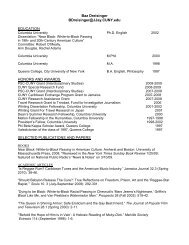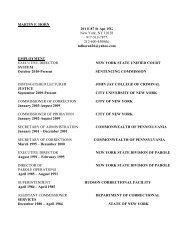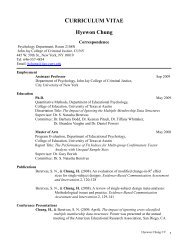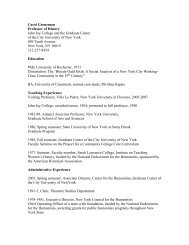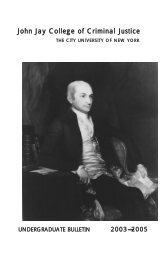Bulletin - John Jay College Of Criminal Justice - CUNY
Bulletin - John Jay College Of Criminal Justice - CUNY
Bulletin - John Jay College Of Criminal Justice - CUNY
You also want an ePaper? Increase the reach of your titles
YUMPU automatically turns print PDFs into web optimized ePapers that Google loves.
FINANCIAL AID<br />
WITHDRAWALS AND THE RETURN OF<br />
TITLE IV FUNDS<br />
As part of the Higher Education Amendments of 1998, Congress<br />
passed new provisions governing what happens to a student’s federal<br />
financial assistance if a student completely withdraws from school in<br />
any semester. The policy covers all federal loan programs, including<br />
Federal Perkins Loan and Federal Direct Loans, but does not affect<br />
Federal Work Study.<br />
During the first 60 percent of the term, students earn Title IV funds in<br />
proportion to the time they are enrolled. If a student receives more<br />
aid than he/she earned, the unearned portion must be returned to the<br />
Department of Education. If a student receives less aid than the<br />
amount earned, he/she may be eligible for a late disbursement. The<br />
new law assumes that a student “earns” federal financial aid awards<br />
directly in proportion to the number of days of the term the student<br />
attends classes. If a student completely withdraws from school<br />
during a term, the school must calculate according to a specific<br />
formula the portion of the total scheduled financial assistance the<br />
student has earned and is therefore entitled to receive up to that point<br />
in time. If a student receives (or the <strong>College</strong> receives on the student’s<br />
behalf) more assistance than the student has earned, the unearned<br />
excess funds must be returned to the Department of Education. If, on<br />
the other hand, the student receives (or the <strong>College</strong> receives on the<br />
student’s behalf) less assistance than has been earned, the student<br />
may be able to receive those additional funds.<br />
The portion of federal grants and loans a student is entitled to receive<br />
is calculated on a percentage basis by comparing the total number of<br />
days in the semester to the number of days the student completed<br />
before withdrawing from classes. For example, if a student<br />
completes 30 percent of the semester, the student earns 30 percent of<br />
the assistance the student was originally scheduled to receive. This<br />
means that 70 percent of the scheduled awards remain unearned and<br />
must be returned to the federal government.<br />
student’s assistance. If a student completely withdraws (either<br />
officially or unofficially) before this point, the student may have to<br />
return any unearned federal funds that may have already been<br />
disbursed.<br />
If a student has received excess funds that must be returned, the<br />
<strong>College</strong> shares with the student the responsibility of returning those<br />
excess funds. The <strong>College</strong> portion of the excess funds to be returned<br />
is equal to the lesser of<br />
• the entire amount of the excess funds, or<br />
• the student’s total tuition and fee charges multiplied by the<br />
percentage of unearned funds.<br />
If the <strong>College</strong> is not required to return all the excess funds, the<br />
student must return the remaining amount. Any loan funds that a<br />
student must return must be repaid according to the terms of the<br />
student’s promissory note. If a student must return any grant funds,<br />
the law provides that the amount to be repaid be to be reduced by 50<br />
percent. This means that the student only has to return half of any<br />
excess funds he/she receives.<br />
Any amount that a student has to return is considered a federal grant<br />
overpayment. The student must either return that amount in full or<br />
make satisfactory arrangements with either the <strong>College</strong> or the<br />
Department of Education to repay the amount. The student must<br />
complete these arrangements within 45 days of the date of the<br />
<strong>College</strong>’s notifying him/her of the student’s overpayment status or<br />
risk losing eligibility for further federal financial assistance.<br />
Once a student has completed more than 60 percent of the semester,<br />
the student can be said to have earned all (100 percent) of the<br />
249



